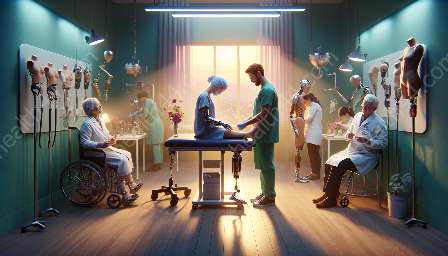Wheelchairs, prosthetic devices, and medical equipment play a crucial role in enhancing the lives of individuals with disabilities. In this comprehensive guide, we will delve into the fascinating world of mobility aids, from the innovative technologies behind modern wheelchairs to the advancements in prosthetic devices and medical equipment. Let's embark on a journey to discover the evolution of assistive devices and the impact they have on improving the quality of life for many individuals.
The Evolution of Wheelchairs
Wheelchairs have a rich history dating back centuries, and the advancements in technology have propelled them into the modern era as sophisticated mobility aids. From manual wheelchairs to electric and power wheelchairs, the evolution of these devices has been nothing short of remarkable.
Manual Wheelchairs
The earliest known wheelchairs were simple wooden chairs with wheels, often requiring a caregiver or attendant to push the user. Over time, manual wheelchairs evolved to include lightweight, foldable designs that offer greater independence and ease of use.
Electric and Power Wheelchairs
The invention of electric and power wheelchairs revolutionized mobility for individuals with disabilities. These advanced devices are equipped with motors and batteries, providing users with independent mobility and greater freedom to navigate their surroundings.
Prosthetic Devices: Enhancing Mobility and Functionality
Prosthetic devices have undergone significant advancements, enabling individuals with limb loss to regain mobility and functionality. Whether it's a prosthetic leg, arm, or any other limb, these devices are engineered with cutting-edge technology and designed to seamlessly integrate into the user's lifestyle.
Advancements in Prosthetic Technology
Modern prosthetic devices utilize advanced materials, such as carbon fiber and silicone, to create lightweight and durable limbs that closely mimic the natural movements of the human body. Additionally, advancements in robotics and sensor technology have further enhanced the functionality and comfort of prosthetic devices.
Medical Devices & Equipment: Innovations in Assistive Technology
Medical devices and equipment encompass a wide range of assistive technologies designed to improve the quality of life for individuals with disabilities. From mobility aids to home healthcare devices, these innovative solutions play a vital role in promoting independence and well-being.
Advancements in Mobility Aids
Beyond wheelchairs, mobility aids such as walkers, crutches, and scooters have seen remarkable advancements in design and functionality. Lightweight materials, ergonomic designs, and enhanced stability have made these devices more user-friendly and versatile.
Home Healthcare Devices
Medical equipment used in home healthcare settings, such as adjustable beds, patient lifts, and assistive bathroom fixtures, have been continually improved to provide greater comfort, safety, and accessibility for individuals with disabilities and their caregivers.
The Intersection of Technology and Accessibility
With the rapid advancements in technology, the intersection of mobility aids, prosthetic devices, and medical equipment has ushered in a new era of accessibility and inclusivity. From smart wheelchairs equipped with navigation systems to robotic exoskeletons that augment mobility, the future of assistive technology holds tremendous promise for individuals with disabilities.
Research and Development
Ongoing research and development in the field of assistive technology are driving the creation of more advanced and personalized solutions. This includes the integration of artificial intelligence, sensor-based feedback systems, and seamless connectivity to enhance the overall user experience and optimize functionality.
Empowering Lives Through Assistive Devices
Wheelchairs, prosthetic devices, and medical equipment have transcended their conventional roles as functional aids to become symbols of empowerment and independence for individuals with disabilities. As technology continues to evolve, these devices will continue to break barriers and enable individuals to live life to the fullest.
From the evolution of wheelchairs to the advancements in prosthetic devices and the innovations in medical equipment, the world of assistive devices is filled with possibilities and opportunities for a more inclusive and accessible future.


